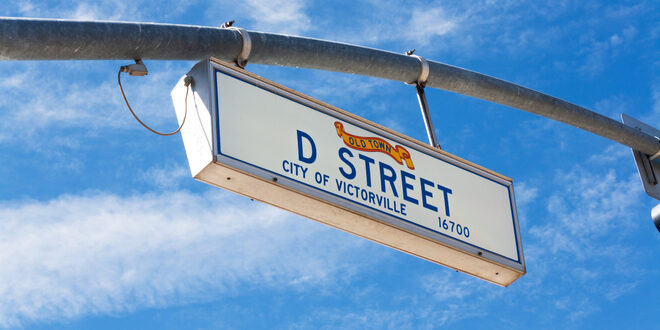City officials plans to use a new funding mechanism provided by the state legislature to fix a major part of Old Town, which has fallen into serious disrepair. Cost of the improvements hasn’t been determined, but Victorville officials believe they can come up with a plan that will work.
Old Town Victorville needs a major upgrade, and city officials have asked its residents to help plan that effort.
Last month, the city council voted to form a Community Revitalization and Investment Authority Board, which will help pay for Old Town’s rehabilitation.
Rather than levy a tax, money for Old Town’s rehabilitation will come from future property tax revenue generated by businesses and residents in that part of the city, which was once Victorville’s main business district.
Starting in the 1960s, more commercial development happened south of the business district and the area came to be known as Old Town. But through the years Old Town has declined to where it’s now plagued by homelessness, decaying buildings, and crime.
Now Victorville [pop. 135,000] wants to revive it, specifically, a 400-acre parcel bordered by Interstate 15 to the north, Mojave Drive to the south, part of Victor Valley High School to the west, and a mix of 11th Street, Stoddard Wells Road, and the Mojave River to the east.
If everything goes as planned, the result will be infrastructure improvements, housing for low to moderate-income families, and loans or grants are given to property owners so they can improve their buildings.
“The city has been trying to revive Old Town for about 25 years, but there have been a lot of false starts,” said Joseph Brady, president of The Bradco Cos. in Victorville, the largest commercial real estate brokerage in the Mojave Desert region of San Bernardino County. “But now they’ve found a way that might work. They want to put more retail and some housing there, and that’s a good idea.”
A Victorville resident, Brady believes now is a good time to revive Old Town.
“People have seen Old Town Temecula and some other areas come back, and that’s created some energy,” Brady said. “The timing is right. People are going to support this.”
The city’s Old Town Specific Plan, a blueprint for development in that part of the city, focuses on the 7th Street and D Street corridors, two of Victorville’s major commercial areas. Several proposed upgrades include making 7th Street Old Town’s main street the focal point of an Old Town renaissance, with shops and businesses that serve tourists and local residents.
The plan recommends reducing 7th Street, which traverses Old Town, from four lanes to two, improving its sidewalks and crossings, and upgrading connections to the Victor Valley Transit Center at 6th and D streets. Those improvements should make Old Town Victorville’s core more pedestrian-friendly and help give it a “24-7” appeal.
It also suggests putting large gateways, signs, and streetscapes at Old Town’s entrances, developing plazas, open spaces, outdoor dining, and better sidewalks All of that will help bring more retail and office to the area.
And, in a move that could generate some public opposition, the specific plan suggests allowing taller buildings in Old Town to create “more density.” That means attracting more retail, and more people, to the area.
Retail is something Victorville desperately needs. Since 2007, the city has seen revenue from retail decline, although that trend may have bottomed out, according to the plan.
But attracting retail to the area targeted for revival is likely to be an uphill battle, given Old Town’s present condition.
“While Old Town possesses a number of amenities … it lacks a strong identity and sense of place that will draw people in,” the plan states. “Safety and security concerns, together with a significant number of vacant and underused sites, unclean environment, and poor building conditions contribute to an unattractive and uninviting district.”
The report also notes a “prevalence of undesirable land uses in Old Town, such as car-oriented drive-throughs, auto sales and services, liquor stores, and surface parking lots, all of which will need to be controlled in order to maintain a safe and inviting pedestrian-oriented district.”
Still, research has indicated that some small businesses might be interested in coming to the area, which currently generates only one percent of Victorville’s annual sales tax revenue, said Sue Jones, Victorville spokesperson.
“Old Town was once the heart of Victor Valley commerce and it still holds vast potential today,” Jones said in an email interview. “For Victorville to be its strongest, all our neighborhoods must thrive. That’s why the revitalization of Old Town stands out to city leaders and community members as a key priority.”
The first Old Town Strategic Plan was adopted in 1995. It identified four land use districts in the community: service commercial, storefront commercial, residential apartment, and residential single family. It allowed for limited industrial use in all four areas.
A second plan was adopted in 2010, but its implementation was blocked two years later when the Brown Administration abolished redevelopment in the state. Up until then, redevelopment agencies had been the best way for cities and counties to remove blight, upgrade their downtowns or special districts and attract commercial development.
But the Community Revitalization and Investment Authority Board, which the state legislature passed in 2015, gives cities and counties a new way to pay for projects like the restoration of Old Town Victorville.
As properties there are developed, their value will increase and they will be appraised at a higher value, ultimately generating more tax revenue. The authority board, which by law can last up to 45 years, will reinvest it in Old Town.
“It’s not exactly like redevelopment, but it’s close,” Jones said. “Some people call it redevelopment 2.0, but the board is not easy to put together. If we get ours in place by the end of the year, we’ll be the first city in California to have one.”
The five-member committee will include two public members and three city council members. Its primary responsibility will be to put together a plan that determines exactly how to spend the money generated by the future tax increment.
Twenty-two people who live and/or work in Victorville have applied to serve on the board. Those applications are being reviewed by Mayor Debra Jones, Mayor Pro Tem Leslie Irving, and City Manager Keith C. Metzler.
A meeting schedule has not been set, but Victorville officials hope to hold the first session in December.
Even in the best of times, transforming a rundown and crime-ridden part of a city is a Herculean task that will never go perfectly. But Victorville officials are determined to push forward with their plan, especially because it doesn’t raise anyone’s taxes.
“It’s the question everyone in city hall is asked the most,” Jones said. “When are you going to do something about Old Town? Not having redevelopment has made fixing Old Town more difficult, but the city’s leadership is committed to this plan.”
 IE Business Daily Business news for the Inland Empire.
IE Business Daily Business news for the Inland Empire.



About time!! Could be nice, coffee shops, outside dining, bars, retail, farmers markets, weekend events, hire professional security.